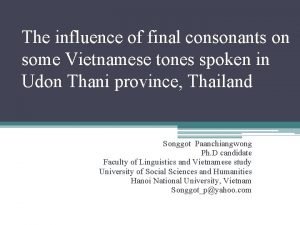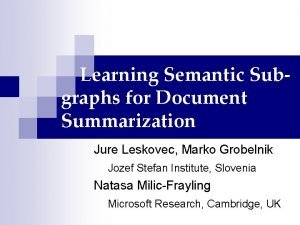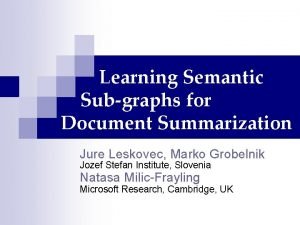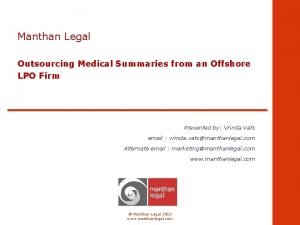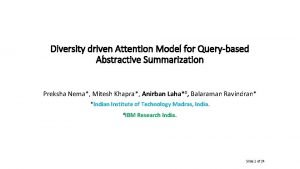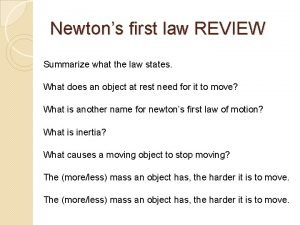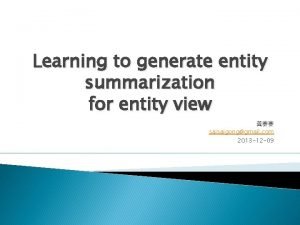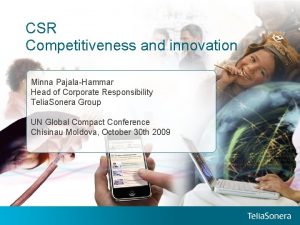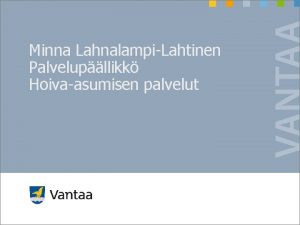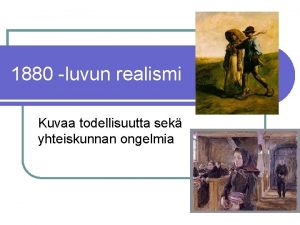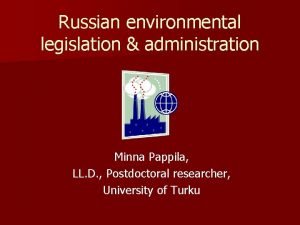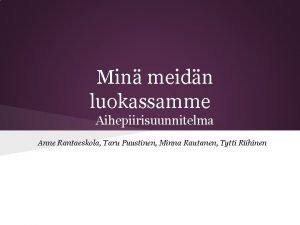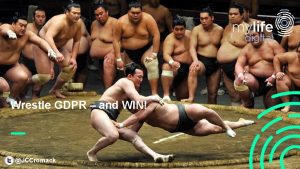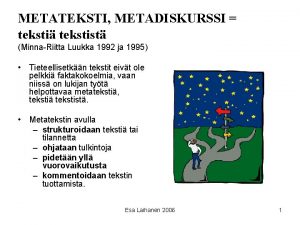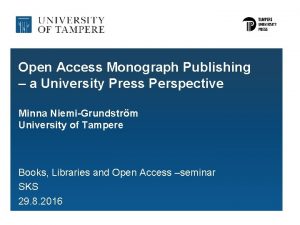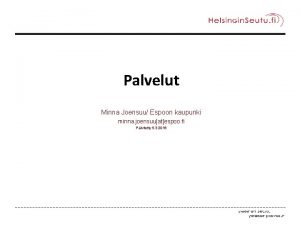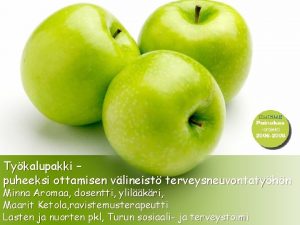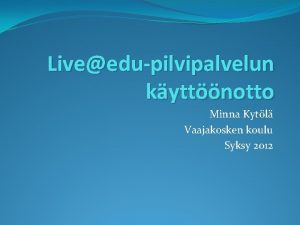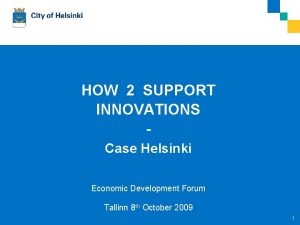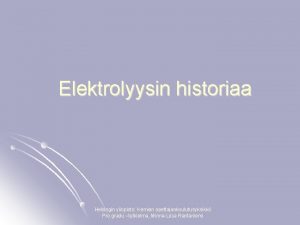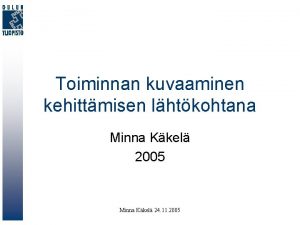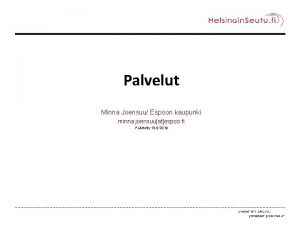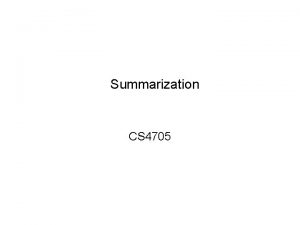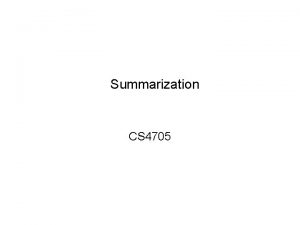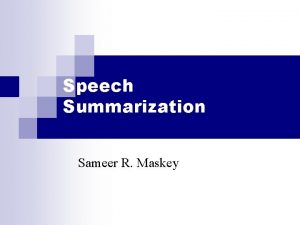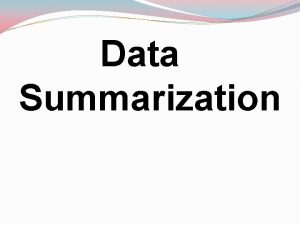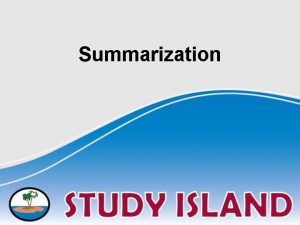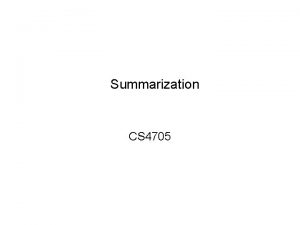Knowledgerich approaches for text summarization Minna Vasankari 27
































- Slides: 32

Knowledge-rich approaches for text summarization Minna Vasankari 27. 11. 2001

Structure 1. The idea 2. Conceptual summarization 3. Linguistic summarization 4. Example system: Plandoc 5. Summary 2

The idea • Full text is not the only possible source material for summarization • Other sources: – databases – simulation data – user interaction sequences – etc 3

The idea • Data with structure – easier to interpret than full text – no source text => no shortcuts – text generation phase is hard – domain-dependency 4

Conceptual summarization • Sorting the source material – facts, events • Choosing what is important – must be included in the summary • and what is potentially important – can be left out or included 5

Conceptual summarization • What is important? – depends on the domain – depends on the input material – depends on the user 6

Conceptual summarization • Importance of a fact – manual decision • Importance of an event – manual decision – frequency analysis 7

Conceptual summarization – Potentially important facts/events are included only if they fit in – Determined by • space limit • linguistic constraints • possible ordering of facts 8

Linguistic summarization • Expressing the same information in fewer sentences • Method: linguistic constructs & revision • Danger: over-effective compression leads to unreadable sentences 9

Linguistic summarization • Linguistic constructs: – semantically rich words – modifiers of nouns or verbs – conjunction and ellipsis – abridged references – abstraction – aggregation – presentational techniques 10

Linguistic summarization • Semantically rich words – killing two birds with one stone Karl Malone scored 39 points. + Karl Malone's 39 point performance is equal to his season high. becomes Karl Malone tied his season high with 39 points. 11

Linguistic summarization • Modifiers of nouns or verbs – one fact specifies a verb or a noun in another fact Jay Humphries scored 24 points. He came in as a reserve. becomes Reserve Jay Humphries scored 24 points. 12

Linguistic summarization • Conjunction – joining facts with "and" or "or" Mick Reynes scored 265 points last season and Jack Jones scored 265 points last season. • Ellipsis – removing repetition Mick Reynes and Jack Jones scored 265 points last season. 13

Linguistic summarization • Abridged references – using shorter names for already introduced things San Antonio Spurs took a 127 -111 victory over Denver Nuggets and handed Denver their seventh straight loss. 14

Linguistic summarization • Abstraction – replacing a series of events with a single event mission start, movements, firing, damages, mission abort => failed mission 15

Linguistic summarization • Aggregation – connecting events with spatial or temporal adverbials Site-A and Site-B simultaneously fired a missile. • Presentational techniques – using spatial or temporal adverbs Site-A fired a missile at 1302. Three minutes later Site-B fired a missile. 16

Linguistic summarization • Revision: approach 1 – First create a draft summary from important facts – Then enrich the draft with potentially important facts • Revision: approach 2 – Generate the draft by collecting similar facts into each sentence – Compress the sentences with ellipsis etc. 17

Example system: Plandoc • Application developed by K. Mc. Keown, J. Robin and K. Kukich at Columbia University, New York and Bell Communication Research (1995) • Problem – a telephone company engineer plans how a telephone route should be developed in the next 20 years – the engineer uses PLAN planning system software – Goal: a documentation of the planning process 18

Plandoc: input and output • Input: a trace of user's actions with the PLAN system 1. RUNID fiberall FIBER 6/19/93 act yes 2. FA 1301 2 1995 3. FA 1201 2 1995 4. FA 1501 3 1995 5. ANF 1201 1301 2 1995 24 END. 856. 0 670. 2 19

Plandoc: input and output • Output: a 1 -2 page report – the initial plan PLAN proposed – refinements the engineer made – alternative refinements the engineer tried but rejected – the final plan • Purpose: documentation 20

Plandoc: conceptual summarization • Important facts – accepted parts of the initial plan + accepted refinements to it = the final plan – rejected refinements? • the engineer decides 21

Plandoc: overview of the method • Fact generator converts the input to an internal representation – facts presented as feature structures (attribute/value pairs) • Ontologizer enriches the facts with e. g. price information • Discourse planner groups the facts • A lexicalizer/sentence generator converts the groups into English 22

Plandoc: processing the input Example: FA 1301 2 1995 Enriched feature structure: class: refinement ref-type: fiber action: activation csa-site: 1301 date: year: 1995, quarter: 2 price: $56. 00 K 23

Plandoc: grouping facts into sentences • Let's construct a sentence from the FA facts: FA 1301 2 1995 FA 1201 2 1995 FA 1501 3 1995 1. Group facts by common action – action = activation for all – one sentence is needed FA 1301 2 1995 FA 1201 2 1995 FA 1501 3 1995 24

Plandoc: grouping facts into sentences 2. For each common-action group (sentence): (a) Collapse groups which differ by one feature into a single group – two groups: FA 1301, 1201 2 1995 FA 1501 3 1995 25

Plandoc: grouping facts into sentences (b) If more than one group remains (sentence is broken into clauses by conjunction): i. Find the feature that is shared across most groups (but has not the same value for all) FA 1301, 1201 2 1995 FA 1501 3 1995 • only the date feature is left and it has two values => two clauses are needed 26

Plandoc: grouping facts into sentences ii. Sort the groups to subgroups by the most common shared feature (nested conjunction inside the clause) – each group has only one member FA 1301, 1201 2 1995 FA 1501 3 1995 27

Plandoc: grouping facts into sentences iii. Repeat the selection of most common shared feature and sorting to subgroups until all have been sorted – no subgroups left iv. Sort the clauses by date FA 1301, 1201 2 1995 FA 1501 3 1995 28

Plandoc: grouping facts into sentences FA 1301, 1201 2 1995 FA 1501 3 1995 • The produced sentence: This refinement activated fiber for CSAs 1301 and 1201 in 1995 Q 2 and this refinement activated fiber for CSA 1501 in 1995 Q 3. • The final sentence after ellipsis: This refinement activated fiber for CSAs 1301 and 1201 in 1995 Q 2 and for CSA 1501 in 1995 Q 3. 29

Plandoc: grouping facts into sentences • Readibility This refinement extended fiber from fiber hub 8107 to CSAs 8128, 8126, 8121 and 8113 and from fiber hub 8120 to the CO in 1994 Q 1 and from the CO to CSA 8120 in 1994 Q 3, with the active fibers placed on the primary path. – limit the number of facts conjoined – limit the number of embedded conjunctions inside a clause 30

Summary • Also other sources than text can be summarized • Problems: – choosing the important elements – generating a compact and readable summary text – domain-dependency 31

Summary • Applications: – automatic weather reports (not predictions!) – simulation reports – patient monitoring system summaries – etc 32
 Text summarization vietnamese
Text summarization vietnamese Text summarization vietnamese
Text summarization vietnamese Text summarization vietnamese
Text summarization vietnamese What is an example of a text-to-media connection?
What is an example of a text-to-media connection? Lyckans minut erik lindorm analys
Lyckans minut erik lindorm analys Medical summaries for law firms
Medical summaries for law firms Abstractive summarization
Abstractive summarization Mustafa sheikh lawyer review
Mustafa sheikh lawyer review Entity summarization
Entity summarization Minna pajala
Minna pajala Minna lahnalampi-lahtinen
Minna lahnalampi-lahtinen Minna söderqvist
Minna söderqvist Minna canth tunnetuimmat teokset
Minna canth tunnetuimmat teokset Minna pappila
Minna pappila Minna rautanen
Minna rautanen Minna vakkilainen
Minna vakkilainen Minna-riitta luukka
Minna-riitta luukka Minna niemi-grundström
Minna niemi-grundström Minna joensuu
Minna joensuu Minna aromaa
Minna aromaa Vaajakosken koulu
Vaajakosken koulu Minna maarttola
Minna maarttola Daniellin pari
Daniellin pari Outline critical approaches to interpreting text
Outline critical approaches to interpreting text Sju för caesar
Sju för caesar Datorkunskap för nybörjare
Datorkunskap för nybörjare Strategi för svensk viltförvaltning
Strategi för svensk viltförvaltning Fspos vägledning för kontinuitetshantering
Fspos vägledning för kontinuitetshantering Vad är verksamhetsanalys
Vad är verksamhetsanalys Tack för att ni har lyssnat
Tack för att ni har lyssnat Centrum för kunskap och säkerhet
Centrum för kunskap och säkerhet Läkarutlåtande för livränta
Läkarutlåtande för livränta Nyckelkompetenser för livslångt lärande
Nyckelkompetenser för livslångt lärande
